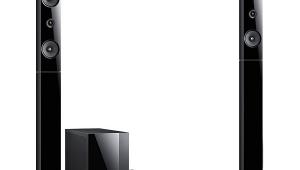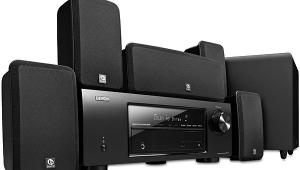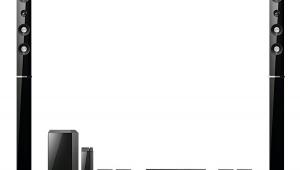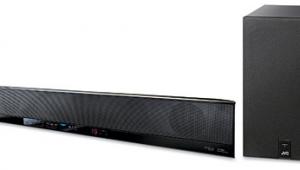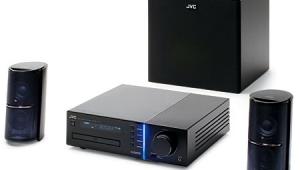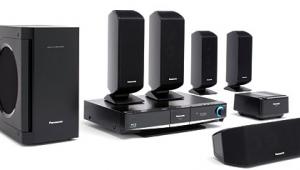Naim n-Vi Home Theater System
There are two ways to look at compact home theater—a.k.a. in-a-box—systems. The dominant, mass-market HTIBs are a step down in cost and performance for those who are content to pay less and get less. If the system comes with fewer distracting bells and whistles, so much the better. But there is another, less explored, higher-end vision for compact home theater. It uses compactness to pursue a vigorous uncluttering of the home theater experience while maintaining high performance. The aim is a kind of sleek austerity, not deprivation, and people who want it are willing to pay for it. They might even influence people around them—suggesting by example that a home theater system can be simple, elegant, and a treat for the ears. Perhaps that's what Naim Audio was thinking when they named this system the n-Vi. I'll spare you the puns.

Button Aesthetics
Just looking at the n-Vi is calming. Less than 3.5 inches tall, it's powered by Tripath Class-T amplifier technology. That's a cousin of Class D. Class-T amps dissipate less power in the form of heat than conventional Class AB amplifiers. That makes them cooler, literally as well as figuratively. They're also smaller, more energy efficient, less expensive to operate, and, if you like, "greener." This kind of product represents the future of audio. Anyone who finds a way to make it sound good is onto something. Naim has made it sound good. Naim is onto something.
The enclosure has a rough matte finish that's curiously pleasing to the touch—you could strike a match on it. There is a ventilation fan on the back, but it makes virtually no sound.
On the front panel are: a disc drawer, a central panel with an illuminated logo, an OLED display, and controls. When the system's powered off, the display shows military time in hours, minutes, and seconds, and the buttons remain subtly backlit.
Instead of being organized by size, shape, and layout, the nine buttons are all the same size and are arranged in a symmetrical grid. This looks fabulous but takes some getting used to. For example, the top row includes power, volume minus, and volume plus, making it all too easy to power down the unit by mistake. On the positive side, there is some ingenuity to the system's control logic. The button labeled Stop performs both the stop and eject functions, and it's easy to find—in the center of the three-by-three grid.
When you're using the system in the dark, you'll want to use the front panel's backlit buttons because the remote has no backlit or glow-in-the-dark keys. It's nearly impossible to find the volume keys buried among 46 other buttons of the same small size. If I bought the n-Vi, I'd get a better-designed universal remote to go with it.
Connectivity choices are limited, as they tend to be in a compact system, and the choices are somewhat odd by American standards. Please note that the digital video output is DVI, not HDMI. It does have HDCP copy protection, though. While you can use an adapter to bridge DVI and HDMI, the results can be hit or miss. I used the component output, using adapters to fit Naim's BNC jacks to my RCA-terminated video cables. Naim also provides a large 20-pin SCART-type video output. This is a common output in Europe, and it's switchable between component or composite output. There is no RCA-type composite video output, but the familiar S-video output does appear. The two five-pin DIN audio jacks integrate with Naim stereo preamps.
Available options include an analog/digital FM tuner ($550), an RS-232 module for external control in a multizone system ($185), and a planned video-scaler update for 1080i and 720p (price unavailable).
The control menu contains pretty much the standard stuff. Audio niceties include a lip-sync control, as well as full left-to-right and front-to-back adjustments for Dolby Pro Logic II. Video features include test patterns and a choice of a 0-IRE or 7.5-IRE black level. Thanks to Faroudja video processing, the n-Vi produces a good picture.
It takes 27 seconds to power up the unit, as a horizontal indicator creeps from left to right. According to the manufacturer: "It self-tests the power supply and checks the status of the Tripath modules—e.g., looks for any short circuits on speaker outputs, checks for optional modules, and loads software."
Welcome to the Club
The n-Vi's most distinctive trait is an extended, airy treble paired with a clean, open midrange. If you've been hankering for more detail from your speakers, the Naim system may be an ideal mate—although, if your speakers are bright, you should look elsewhere. With my Paradigm Reference Studio 20s, the n-Vi created an up-front soundstage that imaged beautifully in stereo and heightened the impact of surround panning.
The Lost City, Andy Garcia's story about a Cuban family's loyalties tested during the rise of Castro, has an eventful soundtrack. Music ranges from the mournful solo trumpet that opens the film to several nightclub scenes featuring a Latin jazz orchestra and a zesty stage show. Adroit juxtapositions of sound elements occur throughout the film—a sudden segue from music to an explosion, an ominous speech giving way to thunder, and waves pounding a shore inserted between a beating and an arrest. Naim's amplification kept up with the dynamics of the pounding waves, the richness of the music, and the action scenes' soundfield complexity.
Adam Sandler's Click is full of synthesized whooshes that the n-Vi delivered like sonic cotton candy, with a little extra brightness and color. The recording of dialogue was on the soft side, but, with the system's strong treble, I didn't miss anything.
 Busy Soundfield
Busy Soundfield
With music, the n-Vi seemed to thrive on naturalistic material like RCA's beautiful 1960 recording of Sviatoslav Richter, Erich Leinsdorf, and the Chicago Symphony performing the Brahms Piano Concerto No. 2. I felt as though I were in the row one-fourth of the way back from the stage, where the dynamics of the great Russian pianist could be largely detached from the hall's ambience. Richter's Decca recordings of Haydn Sonatas Nos. 40, 41, 48, and 52 came across with a startling directness that owed as much to the n-Vi's reproduction of the piano's upper registers as to the masterful and colorful performance.
With movies, I loved hearing heightened surround effects, but the system's surround prowess became distracting when I played Romanza, the Newstead Trio's recording of Piazzolla and others. It was recorded in a church with lots of reverb, and, even after I knocked down the surround channels in the DPLII menu, the reflections still seemed to overpower the musicians.When I switched to stereo, however, the hyperactive soundfield became a beautifully sculpted soundstage with a satisfying, not distracting, degree of depth. Dipole surrounds may work well with this system, but I didn't get to try them.
Digging for DPLII treasure, I hit gold with Nick Drake's Bryter Layter. The system opened up the slightly flat and claustrophobic mix and brytened up its dark corners. Once I knew what I was looking for, it wasn't hard to find more of the same in Kind of Blue by Miles Davis. The CD I have is the first digital mastering, a dull piece of work on most systems. But the Naim teamed up with DPLII to replace a vague soundstage with a spacious soundfield, bringing out the timeless quality embedded in the music.
When I gave it 5.1 discrete channels to work with in the DVD-Audio release of Porcupine Tree's album Deadwing, the system dazzled. But it was honest enough to reveal the almost insignificant digital glaze of home-studio productions like Bert Jansch's The Black Swan and Richard Thompson's Front Parlour Ballads. It could play plenty loud. The Class-T amps ran warm, not hot, even after hours of powering speakers of slightly below-average sensitivity.
Before we move into the home stretch, let's briefly review the kinds of components that would function best with this system: DVI-in or component-in displays, speakers with reticent mids/highs, dipole surrounds, and a backlit accessory remote. If that sounds like your gear, and you'd like your equipment rack to lose a few pounds, this may be the compact system for you.
Real Finesse
The Naim n-Vi brings an impressive list of qualifications to the genre of compact home theater systems. It has some real finesse with naturalistic recordings and dialogue reproduction. It constructs a soundfield extraordinarily well for a small system. And it's one of the few compact surround systems that not only functions in stereo but excels with it. On the whole, it's a winner.
* Audio editor Mark Fleischmann is also the author of the annually updated book Practical Home Theater (www.quietriverpress.com).
Highlights
• A high-end approach to the compact home theater system
• Truly good sound in a truly attractive and compact package
• Includes a five-channel amp and disc player; no speakers
- Log in or register to post comments
